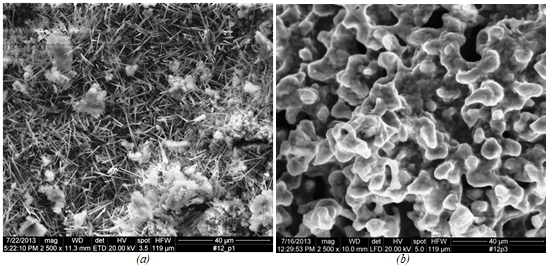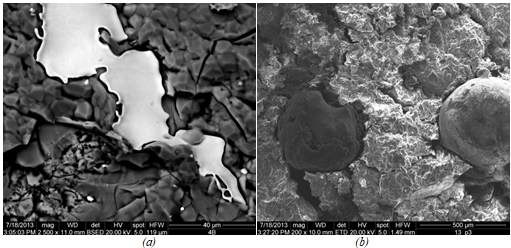ВЛИЯНИЕ ПОВЕРХНОСТНОГО НАТЯЖЕНИЯ РАСПЛАВА ВОССТАНОВИТЕЛЯ НА МЕТАЛЛОТЕРМИЧЕСКОЕ ВОССТАНОВЛЕНИЕ ОКСИДА КАЛЬЦИЯ
Фалин В.В.1, Минков А.О.2, Сухарев А.В.3, Тарасов В.П.4
1Аспирант НИТУ «МИСиС»; 2науч. сотр. ООО Фирма «Вак ЭТО»; 3зам. ген. директора, ООО Фирма «Вак ЭТО»; зав. каф. цветных металлов и золота, НИТУ «МИСиС».
ВЛИЯНИЕ ПОВЕРХНОСТНОГО НАТЯЖЕНИЯ РАСПЛАВА ВОССТАНОВИТЕЛЯ НА МЕТАЛЛОТЕРМИЧЕСКОЕ ВОССТАНОВЛЕНИЕ ОКСИДА КАЛЬЦИЯ
АннотацияПроведены исследования металлотермического восстановления оксида кальция алюминием и чугуном в одинаковых условиях при одинаковом атомном содержании восстановителя. Показано, что различие в выходе кальция "сопровождается" различием в микроструктуре брикетов: для восстановления чугуном структура соответствует случаю ограниченной смачиваемости восстановителем твердого CaO; соответственно, выход кальция при алюминотермическом восстановлении оксида кальция более чем в 2,5 раза выше, чем в случае восстановления чугуном. Существующее противоречие между наблюдаемыми, например, при алюминотермическом восстановлении параметрами восстановления и значениями энергии активации диффузии кальция и теплоты испарения кальция может быть преодолено, если при анализе учитывать зависимость поверхностного натяжения от температуры. Предложена модель "перемещения" расплава восстановителя по поверхности CaO, которая была проверена на соответствие известным литературным данным. Получена формула расчета выхода кальция в зависимости от параметров процесса. В основу выбора металла – восстановителя должен быть положен критерий смачиваемости им поверхности оксида.
Ключевые слова: кальций; оксид; металлотермическое восстановление, смачиваемость.Falin V.V.1 , Minkov A.O.2, Sukharev A.V.3, Tarasov V.P.4
1Doctoral student (National University of Science and Technology “MISiS”; 2Research officer “Vac ETO” Ltd.; 3Vice CEO “Vac ETO” Ltd.; 4Head of Chair Nonferrous and Gold metals institution, NUST “MISiS”
REDUCTANT MELT BOUNDARY TENSION EFFECT ON METAL THERMAL REDUCTION OF CALCIUM OXIDE
Abstract
Metal thermal reduction of calcium oxide by aluminum and iron shot were investigated in equal conditions and the same atom reductant content. The discrepancy between the calcium yield is demonstrated by difference in the briquette microstructure: the structure corresponds to the case of limited wetness with the solidified CaO reductant when it reduced by the iron shot; consequently, the calcium yield is 2.5 times higher in aluminothermic reduction of the calcium oxide than iron shot reduction. The existing contradiction between examined parameters such as those, which defined in the aluminothermic reduction and energy activating diffusion and heat of evaporation, could be got over, if boundary tension dependence per temperature would be accounted in the analysis. There is a model suggested for melt reductanct “transformation” within the CaO surface that was examined on correspondence with literature data. The formula of calcium yield calculation was obtained according to parameters of the process. As a base of choosing of the reducing metal, there should be a criteria given upon the wetting it with (in) oxide surface.
Keywords: calcium, oxide, metal thermal reduction, wetness.
Aluminothermic reduction of calcium oxide is the well-known process that employed in the industry [1]. Silicothermic reduction of calcium oxide is studied poco meno[2]. Anyway, the cost of the metal reductant relates to 60% from the initial recovery value. This stimulates on new, far cheaper alterations with reductants, which require analysis in dynamics.
Traditional approach supposes chemical reduction reaction with following diffusion of the calcium reduced to the surface and its evaporation. It has been established that temperature diffusion coefficient dependence with partial tension is exponential. Consequently, energy parameters of the process are available to estimate (energy diffusion activation or heat of evaporation) analyzing the calcium yield (calcium amount ratio that is sublimed to the initial calcium amount in the CaO).
The calcium oxide yield dependence to the temperature for aluminothermic reduction is given in issues such as [3, 4]. The energy activation values, obtained by analysis of yield dependence from the temperature in the calcium oxide reductive process, mentioned in the [3, 4], are 42kJ/mol-47kJ/mol. These values are three-four times higher than the heat of evaporation of calcium, described in several observations, such as [5], and energy activation values of calcium diffusion in structures close to calcium aluminosilicate [6]. The reason of such discrepancy is still not clear.
In the present study results of CaO reduction by aluminum powder and iron shot in identical conditions were investigated.
The following compositions were used such as (wt. %):
- Calcium oxide , trademark Schaefer Precal produced by Schaefer Kalk GmbH, with calcium carbonate component ~2pct and hydroxide ~1pct; MgO – 0.5pct; SiO2 – 0.1pct;
- Aluminum APV; these components exhibit in the Al composition: Mn – 0.38pct, Cu – 0.063pct, Si – 0.065pct, Fe – 0.31pct, Mg – 2.1pct, Zn – 0.06pct, C – 0.023pct, and Ti – 0.65pct; fraction size ≤2mm; active aluminum content – at least 98,3%;
- Iron shot number 0,5 of composition with C~4pct, Si – 1.2 to 2.0pct and Mn – 0.4 to 0.7pct.
After calcium oxide powders with reductant (R) were stirred carefully in the constant ratio 80at. %:20at. %, respectively, the samples were pressed in briquettes at 100MPa pressure; the calcium oxide reduction process was treated in the vacuum furnace type VOzh-16-22 at 13500C within 3hours and residual pressure 1Pa as calcium vapors were deposited to the cool-water condenser. Mass estimation was provided by laboratory scales AJ-620CE, X-ray examination of the used charge was taken on analytical complex ARL9900 Workstation IP3600 in the CuKα radiation, structure-morphological observation was carried out on the scanning electron microscope FEI Quanta 600 FEG with accelerating voltage ~20kV.
Figures 1 and 2 demonstrated the charge microstructure after calcium oxide reduction by aluminum (fig. 1) and iron shot (fig. 2). The calcium yield was 0.38±0.02 for the aluminothermic reduction and 0.14±0.03 for iron shot reduction.

Fig. 1. Briquette microstructure after aluminothermic reduction in secondary and backscattered electrons (a) and secondary electrons (b): a) imaging from the external sample surface b) imaging from the briquette fracture surface
There are line element structures observed in the figure 1(a) with thickness 102-103nm. X-ray structure analysis identifies following phases in the charge: Ca12Al14O33; CaAl2O4; Al2Ca. Based on data, obtained by energy-dispersion microprobe adaptor EDAX, the ratio deals as O: Al: Ca=27:13:7 in the determined line structure, the last might be prescribed to CaAl2O4 phase.
In the depth of the sample on the surface fracture (fig. 1(b)) there is a ratio of O: Al: Ca=62:24:15 defined by EDAX results, which correspond to calcium aluminate mixtures with composition: Ca12Al14O33:CaAl2O4 ≈2:3.
When aluminum substituted to iron shot, the phase composition of the charge is changed after reduction: CaO and Fe (fig. 2).

Fig. 2. Briquette microstructure after iron shot reduction in backscattered electrons (a) and secondary, and backscattered one (b): a – imaging from the external sample surface; b – imaging from the briquette fracture surface
While the iron shot essentially reduce calcium oxide, the spheres exhibit in the briquette structure, in the composition which is calcium either iron. Furthermore, spherical structures were found in the central part of the briquette (imaging from the briquette fracture surface), specific for the event of the limited wetting.
We considered [7] that significant part is the metal oxide capability to be wetted by the reductant in addition with its unity. Therefore, the specific yield could be define as
![]() (1)
(1)
where K1 is the factor of proportionality, which is dependent from properties of the specific reductant;
Q - calcium heat of evaporation
S – evaporating space from the container (crucible)
Metal thermal reduction of calcium oxide includes all basic factors of the liquid-phase sintering: powder mixing, pressing, heating till the forming liquid phase temperature (reductant melt), and holding. Such opportunity is able to take purchase on theoretical base of the investigation upon powder metallurgy [8].
As it is reported, the “capillarity” have a dominate role in isothermic liquid-phase sintering, which affect on liquid grain bridges. The space size change of the contact per time “t” is described by the equation:
![]() (2)
(2)
where ΔF and F are space size change and initial space, respectively; a and n are typical constant values for the operating mechanism. As it is mentioned in the [8], the use of this equation demonstrated good agreement with experimental data for ceramic and metallic powders. Besides, if n=0.5, the process will be regulated by the chemical reaction, and if n =0.33, the diffusion process is the controlling part of dissolving and separation.
As the yield Y is proportional to the calcium reduced evaporating pressure at constant instrumental conditions and constant time, and calcium reductions from oxide is the result of the chemical reaction, the yield could be defined with the following:
![]() (3-10)
(3-10)
where K is the factor of proportionality, which is dependent from properties of the specific reductant;
t – time of reduction.
In the suggested model of surface tension force with changing surface texture (reduction and evaporation of calcium) the metal reductant melt is transported to new parts of the surface. Fundamentally, it is observed the same mechanism of reactive cooperation for reductive processes in the liquid phase presence, which bears collective character as well reacting sintering in the liquid phase [9].
The interesting model with “transportation” of the melt was checked on correspondence with reported experimental data. Dependence from reducing temperature and time is satisfactorily corresponding with experimental data.
By this means, while choosing the efficiency of the metal thermal CaO reduction, an important way is availability to wet out of calcium oxide by reductant.
References
- Market report of the metal calcium in Russia and world. http;//www.infomine.ru August 2011-12
- Doronin N.A. Calcium. M.:Gosatomizdat, 1962 – p.190
- Kulifeev V.K., Kropachev A.N., Miklushevskiy V.V., Vatulin I.I. Aluminothermic technology in obtaining calcium and hardware registration// Nonferrous metals, 2004, #10, p. 58-61
- Vatulin I.I., Minkov O.B., Sukharev A.V., Sukharev V.A., Shingarev E.N. High Temperature aluminothermic reduction of calcium oxide// Material Science, 2009, # 3, p 46-50
- Physical and chemical properties of elements. Almanac. Edited by Samsonov G.V., Kyiv, Naukova dumka, 1965. – p.808
- Schwandt C.S., Cygan R.T., Westrich H.R. Ca self-diffusion on grossular garnet.// American Mineralogist. 1996, vol. 81, pp. 448-451
- Falin V.V., Minkov O.B., Molev G.V., Sukharev A.V., Tarasov V.P. Availability in changes of aluminum in producing metallic calcium by reducing its oxide/ Nonferrous metals, 2014, # 1, p.53-58
- Physical metal technology. Vol. 3/edited by Kan.R.U., Haasen P. Vol.2. Phase transformations in metals and alloys, and alloys with specific properties. M.: Metallurgy, 1987. P. – 624
- Solntsev V.P., Skorokhodov V.V., Solntseva T.A., Collective processes in reacting sintering with liquid phase// Powder metallurgy, 2013, #3/4, p.23-30
